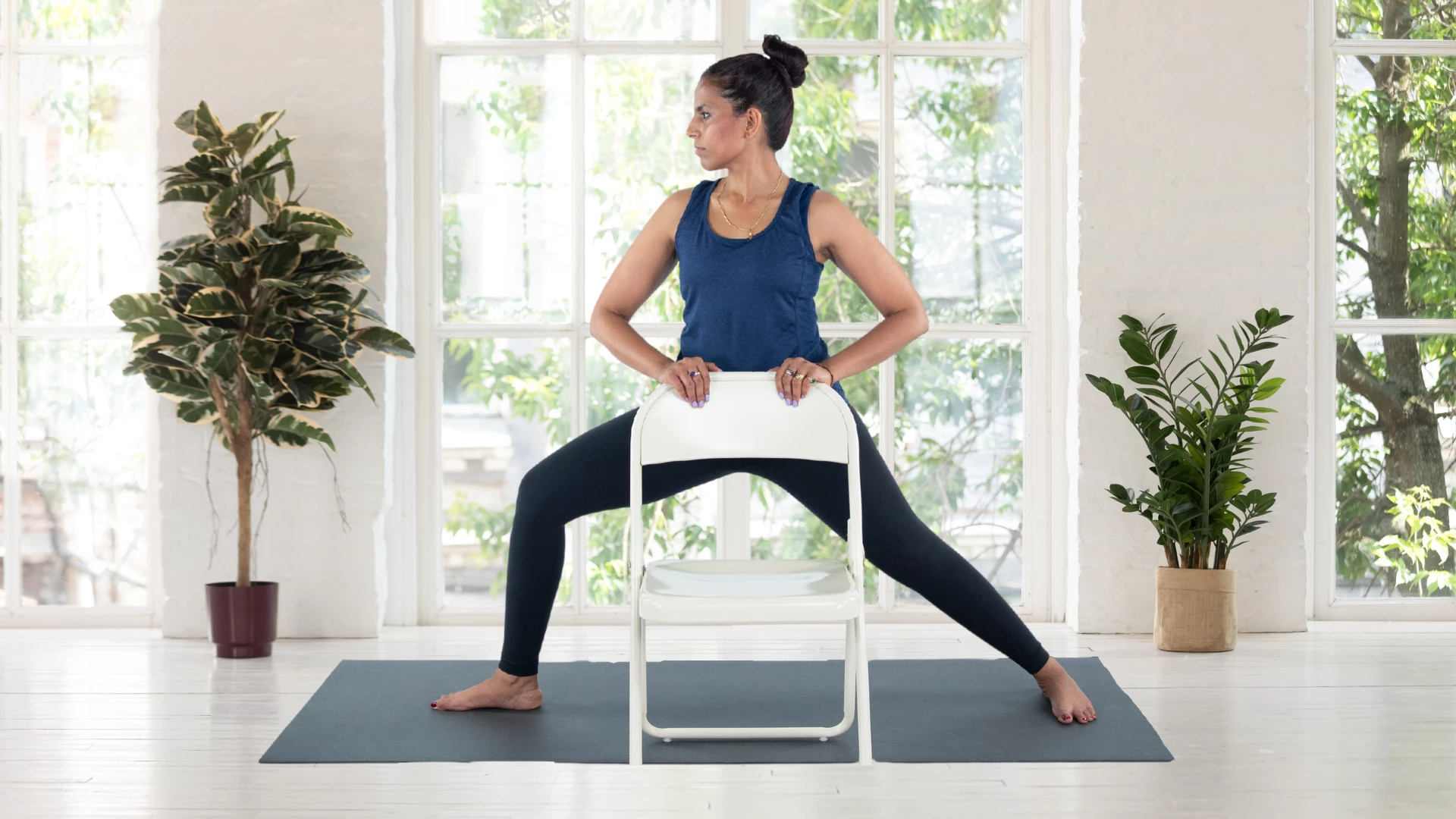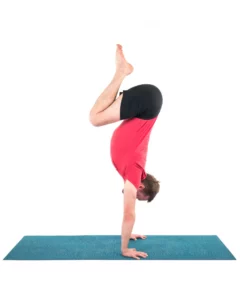Improve Balance With This Supported Variation of Warrior II Pose

Article At A Glance
Don’t underestimate the importance of props to support your Warrior II! By focusing on alignment in Supported Warrior II, the strength and muscle memory you gain from this shape will carry over to other Warrior poses. Learn how here!
Who would benefit from trying Supported Warrior II Pose? Well, we’ve all struggled with balance before. Sometimes our muscles don’t want to hold a shape, and sometimes our minds are spinning all over the place, making us lose our footing. Yoga has so many balancing postures that it can feel overwhelming on our “off” days.
Thankfully, props and tools like a wall can be a saving grace to help stabilize, support, and even improve your balance. By removing major elements of balance with the support of props, you can instead focus on alignment and activation. Through this, you will work to stabilize and strengthen the muscles that help to support your balance. And so when you remove the props, you’ll be that much more secure in your balancing poses.
Warrior II Pose (Virabhadrasana II) isn’t a one-legged posture, but it still requires a great deal of balance. But beyond the element of balance, Warrior II Pose is an incredibly complicated posture. With so many different actions happening in the legs, torso, and arms, it can be a lot to support on its own, even before the added challenge of balance on top.
This variation of Virabhadrasana II helps to almost eliminate the element of balance so that you can focus on all the other juicy parts of the pose: the external rotation of the front thigh, the energetic activation of the legs, the engagement of the core, the length through the spine, and so on. By removing the balance factor in supported Warrior ll, you instead draw your awareness to the activation of your muscles; you may be surprised by how much effort it takes to support this shape without even having to balance.
Once you’ve mastered the engagement needed, you’ll probably be surprised to find how much simpler the balance becomes when you effectively activate the muscles of the legs and core.
Try This Supported Warrior II Pose to Improve Your Balance and Alignment
For this variation, you will need a wall, a yoga block, and a chair for supported Warrior ll Pose.
- Set up your mat with the short edge against a wall.
- Place a block on its lowest height setting against the wall at the top of your mat. Position the block so that the long edge of your block is parallel to the short edge of your mat.
- Place a chair in front of the long edge of your mat for support.
- Come into a wide-legged stance facing the chair with the pinky side of your right foot against the side of the block that is parallel to the wall. Walk your feet out roughly the length of your own leg away from each other.
- Press down into your feet and feel your legs activate. Ground down firmly into the earth.
- Lift the front of your hips up and engage your belly. Hug your navel toward your spine and slightly up toward your ribcage.
- Pop your left heel off the floor and soften your knee. Externally rotate your front thigh so that your foot rotates 90 degrees. Roll your left knee to face toward the top of your mat and release your heel back down to the floor.
- Elongate your back body. Stretch the crown of your head and your tailbone in opposite directions.
- Press your hands into the top of the chair in front of you to support your balance as you bend your front knee deeply.
- Press into the pinky side of your right foot and keep it grounded on the floor. Maintain the external rotation you created in your left hip to allow your knee to track forward and roughly toward the center of your front foot.
- Allow your back hip to rotate forward slightly to accommodate for the rotation in your front hip.
- Press the pinky side edge of your back foot into the block and into the wall behind you to strongly stabilize your back leg.
- Without movement, energetically (isometrically) contract the muscles of your legs by drawing them toward the midline of your mat and your body. Hug all your energy in and up from your legs through your core and your spine.
- You can stay and hold isometrically, or if you’d like to make the pose more dynamic, you can bend and straighten your front leg to build some extra heat in your front thigh.
- Whichever variation you choose, maintain it for about five to 10 full cycles of breathing and then slowly release out the way that you came in.
- Reset your props and repeat all the same actions on the opposite side.
Never Underestimate the Power of Support
By using the support of a chair and wall, you can forget about the balance element in the Supported Warrior II Pose and focus on the alignment of your body and the activation of your muscles. This increase in attention to the minutiae of this pose will surprisingly improve your balance if and/or when you decide to remove the props. When your balance is not as challenged, you’re also able to hold the pose for longer, allowing the details to really permeate into your muscle memory.
By focusing on creating a stable alignment of your bone structure and a strong engagement of your supporting musculature, the activation created and imprinted into your muscle memory through Supported Warrior II Pose will translate to many other Warrior poses and similar shapes throughout your practice. So don’t underestimate support—it’s a powerful tool to help you advance in your asana practice,
*video with Kate Vigmostad
Also, read...
Keep Your Hips Happy With This Anatomically Sound Warrior 2 Alignment
Balancing Act: Warrior III with Yoga Blocks
Warrior l An Essential Yoga Pose for Strength and Stability
Related courses

Leah Sugerman is a yoga teacher, writer, and passionate world traveler. An eternally grateful student, she has trained in countless schools and traditions of the practice. She teaches a fusion of the styles she has studied with a strong emphasis on breath, alignment, and anatomical integrity. Leah teaches workshops, retreats, and trainings, both internationally and online. For more information, visit www.leahsugerman.com.



